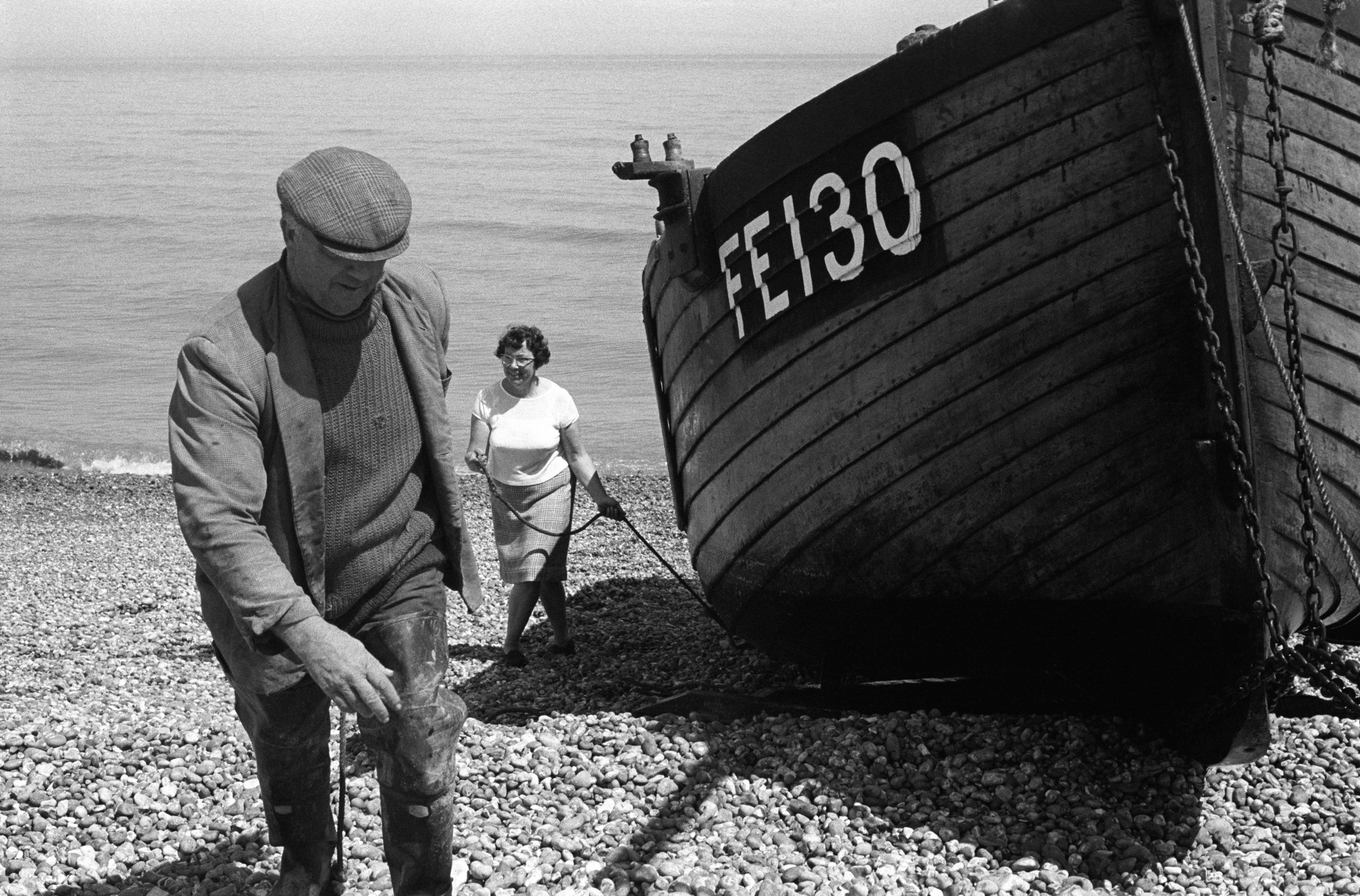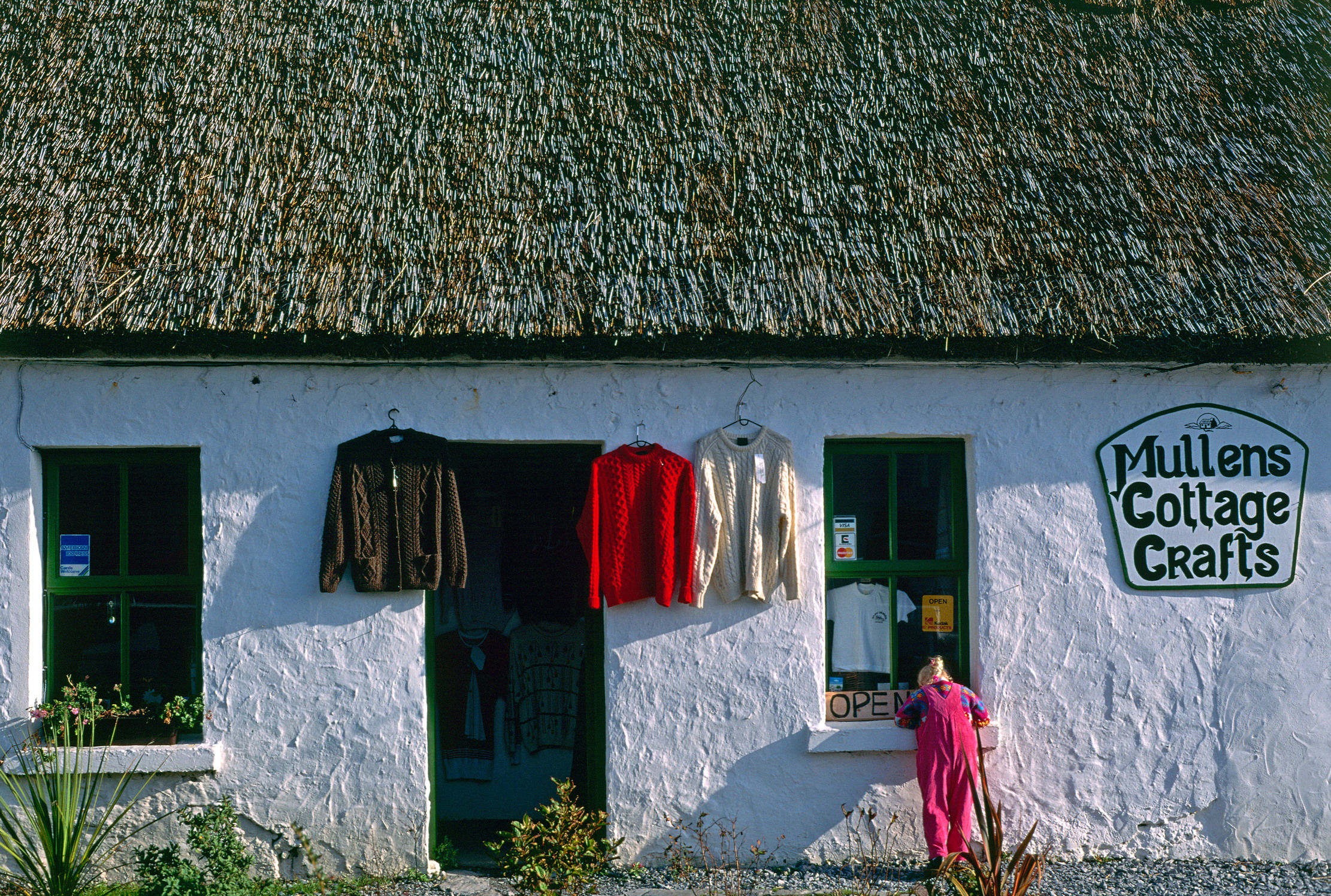'Daniel Day Lewis rang up one day... he wanted us to make him one in a Staithes pattern': Why the gansey jumper is still a compelling yarn
Designed to protect the wearer from wind, rain, salt spray and sun, chunky gansey jumpers retain a special place in fishermen’s hearts and modern fashion.


Cornish boat-builder Jonny Nance has worn a gansey every day for most of his life. ‘They’re fairly tight-fitting, so they don’t get caught in what you’re doing,’ he explains. ‘There are no pockets or buttons to snag on a net and they work well at sea, allowing you to steam rather than sweat.’
He cares deeply about maritime history: when not at work, he builds replicas of the Victorian fishing vessels that were once a common sight in his home town of St Ives, as a means of honouring seafaring traditions. ‘You could say the gansey tells the same story,’ he adds.
Also known as the guernsey, jersey and knit-frock, the gansey is a traditional fisherman’s sweater originating in the Channel Islands — hence the name — in the 17th century and still produced in coastal communities from Scotland to Cornwall. Knitted ‘in the round’ on five needles without seams, from tightly spun five-ply worsted wool (originally with the lanolin still in it, which lent water-resistance), they were designed to protect the wearer from wind, rain, salt spray and sun. Chunky patterning on the yoke provided extra warmth.
By the 19th century, ganseys were well known across the British Isles: one story has Nelson recommending them to the Admiralty. Today, Mr Nance buys his from Di Tomlinson at Sea Dogs, which offers them with a choice of motif. ‘I wanted a St Ives Double Twist last time,’ he confides, ‘but it’s quite elaborate and she wasn’t making them any more, so I got a Polperro Musician instead.’ When the cuffs or collar fray, he gets replacements hand-knitted.
A post shared by Thomas James Powell (@thomasj_powell)
A photo posted by on
‘Guernseys were made to last,’ writes Mary Wright in her 1979 book Cornish Guernseys and Knit-frocks. ‘The deep indigo dye of the first knitting gradually faded in the light and salty air to a lighter navy through a purple shade to green and grey, corresponding to the colours of the Cornish sea in all its moods and seasons.’
A decade before sitting down to write the book, Mrs Wright had resolved to knit her first gansey, yet couldn’t find any written instructions, so she copied a Cornish pattern from an old photograph. It set the hare running and she went on to record two dozen distinct patterns particular to seafaring villages across the county, from the Port Isaac Double Rope to the Bude Ladder, the Lizard Lattice and the Polperro Laughing Boy.
She quizzed older fishermen, who recalled integral pockets for watches (‘they worked better when they were warm,’) and the wearer’s initials knitted into the armpits. ‘My Granny knitted hundreds,’ one man told her. ‘My uncle Willie lost his and, 12 months later, Granny saw a man wearing it and called a policeman to arrest him. “You make’n lift up his arms,” said Granny. “You’ll see I knitted a ‘W’ under one arm and an ‘S’ under the other and my boy’s name is Willie Steer — what’s his?”’ It was said that you could tell which village a drowned fisher-man came from by the pattern of his gansey.
Exquisite houses, the beauty of Nature, and how to get the most from your life, straight to your inbox.
Knitting ganseys provided an income for women whose husbands were at sea or working abroad. They knitted everywhere, notes Mrs Wright — on doorsteps, at the well, on the harbour wall — and talked and walked as they worked. ‘You could hear them coming from the clack, clack of their needles.’ A carved wooden sheath hooked through the waistband served as a holder for the working needle, enabling them to knit faster. They sold their work at fairs or on contract to agents.

A long way north, groups of women would pack up their knitting pouches to follow shoals of migrating herring from Scotland down the East Anglian coast. Known as the herring girls, their principal job was to gut and salt the fish, although they would knit as they waited for the trawlers to bring in the day’s catch. ‘It was hard work, with chapped, sore fingers,’ observes Frankie Davies of Charl Knitwear, who makes contemporary ganseys, having studied original Norfolk designs. ‘Every village adapted patterns: some might incorporate a flowerpot stitch; others would represent a ploughed furrow or hearts.’
At Norfolk’s Sheringham Museum, a group of knitters examined an archive of images of local fishermen by the celebrated photographer Olive Edis. ‘The photos are such good quality that they were able to chart the individual patterns of the ganseys and knit up mini samples for display,’ reports curator Lisa Little. ‘Sheringham women knitted finer than anyone, with 12 stitches to the inch, so you could fit in more pattern to protect against the cold east wind.’
These days, most traditional designs are reproduced on knitting machines, but according to Lesley Berry at Flamborough in East Yorkshire ‘a gansey is not a gansey unless it is hand knitted’. She is quite firm on this and employs experienced knitters to produce ganseys in a variety of north-coast patterns, made to measure and priced at about £500 each. There is a minimum two-month waiting list, and the company’s admirers include some household names.
‘Daniel Day Lewis rang up one day,’ she reveals. ‘He had found an old, moth-eaten gansey belonging to his father, Cecil, and he wanted us to make him one in a Staithes pattern. Later, he ordered a Filey for a film he was in. He sent handwritten letters of thanks to each maker.’
Jane Wheatley is a former staff editor and writer at The Times. She contributes to Country Life and The Sydney Morning Herald among other publications.
-
 Suit yourself: I’m a 49 year-old man-about-town and I’ve never owned a suit
Suit yourself: I’m a 49 year-old man-about-town and I’ve never owned a suitWhen Hugh Smithson-Wright turned up to Country Life's annual Gentleman's Life party sans suit, it sparked a passionate conversation about why the formal fashion just isn't for everyone.
-
 'The ugliness and craziness is a part of its charm': The Country Life guide to Bangkok
'The ugliness and craziness is a part of its charm': The Country Life guide to BangkokWhere to stay, where to eat and what to do in the Thai capital.
-
 Suit yourself: I’m a 49 year-old man-about-town and I’ve never owned a suit
Suit yourself: I’m a 49 year-old man-about-town and I’ve never owned a suitWhen Hugh Smithson-Wright turned up to Country Life's annual Gentleman's Life party sans suit, it sparked a passionate conversation about why the formal fashion just isn't for everyone.
-
 Meet the British perfumers squeezing landscapes into scents
Meet the British perfumers squeezing landscapes into scentsThe nuances of modern perfumery now allow a single drop to evoke an entire landscape. Amie Elizabeth White explores the native houses hitting the right notes
-
 This machine is what happens when the Rolls-Royce of motorbikes and the most innovative of watchmakers join forces
This machine is what happens when the Rolls-Royce of motorbikes and the most innovative of watchmakers join forcesBrough Superior and Richard Mille, two brands renowned for perfection, have created something that is exactly that.
-
 ‘Each one is different depending on what mood I’m in, how I'm feeling and how my energy is’ — meet the carver behind Westminster Hall's angel statues
‘Each one is different depending on what mood I’m in, how I'm feeling and how my energy is’ — meet the carver behind Westminster Hall's angel statuesBespoke woodcarver William Barsley makes unique scale replicas of the angels that gaze over Westminster Hall, the oldest part of the palace of Westminster.
-
 If chess is 'the supreme board game', then it deserves to be played on boards like these
If chess is 'the supreme board game', then it deserves to be played on boards like theseChess sets and backgammon boards are a familiar sight on drawing-room tables, but one expert Highland woodworker is refashioning their forms in beautiful new ways.
-
 A slick looking off-roader that's a far cry from its rustic rural roots — Volvo EX30 Cross Country
A slick looking off-roader that's a far cry from its rustic rural roots — Volvo EX30 Cross CountryThe latest iteration of Volvo's Cross Country is flashy, fast and stylish. But is that what a Volvo Cross Country is supposed to be?
-
 'Gems of enflamed transparencies, of bottomless blues, of congealed opals': Why glass was perfect for the elemental experimentalism of Art Nouveau
'Gems of enflamed transparencies, of bottomless blues, of congealed opals': Why glass was perfect for the elemental experimentalism of Art NouveauArt Nouveau masters such as Louis Comfort Tiffany and Émile Gallé turned the most fragile of materials into iridescent masterpieces that shimmered like seashells or glittered like Byzantine mosaics.
-
 Why you absolutely need an electric Bentley Blower furnished with Russian reindeer leather
Why you absolutely need an electric Bentley Blower furnished with Russian reindeer leatherA collaboration between Hedley Studios and The King's shoemaker George Cleverley has produced something rather remarkable. Jeremy Taylor goes for a drive.
